Building of the Month - October 2018


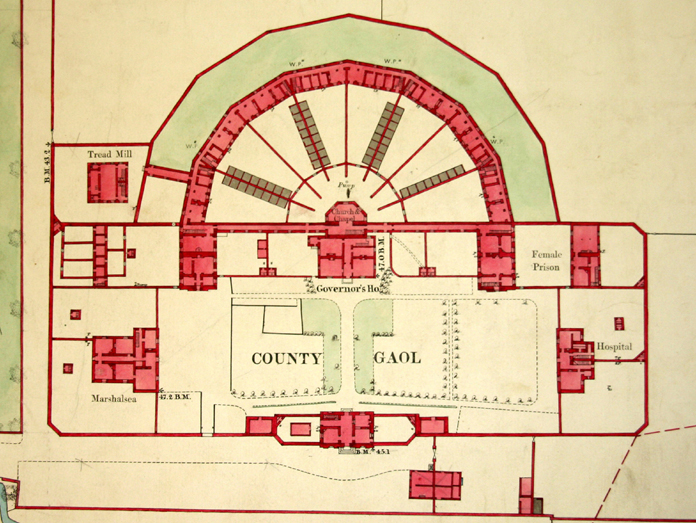
Figure 1: An extract from the Ordnance Survey showing the Sligo Gaol complex described in 1837 by Samuel Lewis as ‘a handsome and substantial building, erected on the polygonal plan at the expense of £30,000: the governor’s house is in the centre, and the debtor’s ward and the hospital form two advanced wings; it is well adapted to the classification of the prisoners, each of whom has a separate sleeping cell; it has a tread-mill for hard labour, a school, and a surgery and dispensary within its walls: and all its departments are under excellent regulations, and it is in high repute for discipline and order’
In 1813 the Sligo Grand Jury appointed three commissioners to supervise the provision of a new County Gaol: Edward Synge Cooper (1762-1830) of Markree Castle, Colonel John Irwin of Tanrego House and Owen Wynne (1755-1841) of Hazelwood House. A site comprising almost seven acres in Abbeyquarter North, on the eastern fringes of the town, was selected for a complex intended to hold up to one hundred and sixty inmates. The estimated cost of the gaol was originally set at £22,000 and The Grand Jury voted £14,000 towards the construction. The contract was awarded to the Sligo-based builder John Lynn (d. 1864) who was later responsible, as architect and builder, for the county gaol (1821-31) in Downpatrick, County Down. Today, in Sligo, Lynn’s memory is perpetuated by an ivy-cloaked cast-iron faucet embossed JL 1818.
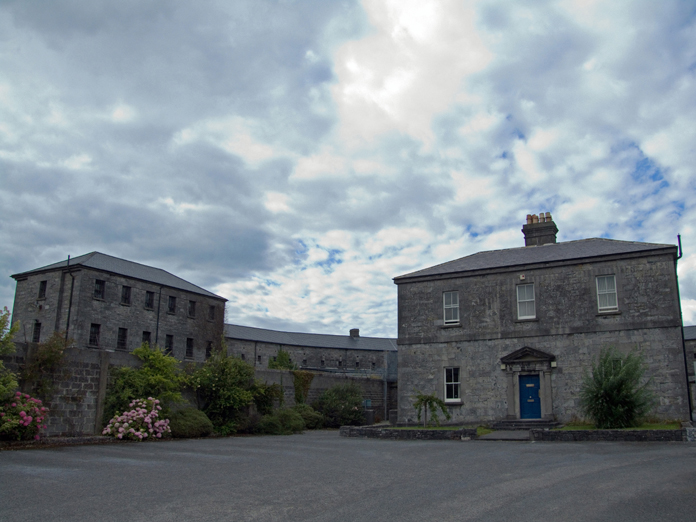
Figure 2: The identity of the architect of Sligo Gaol has been disputed but the builder, John Lynn (d. 1864), ensured that he would always be remembered by installing a faucet embossed JL 1818
The new gaol was based on the Panopticon developed by the philosopher and social theorist Jeremy Bentham (1747-1832) in the late eighteenth century. The Panopticon allowed for a polygonal arc of cell blocks radiating from a central house where the governor could easily monitor the prisoners and his staff and ensure a balanced and fair system of justice. Walled exercise yards, segregated according to the eight criminal classes, filled the spaces between the cell blocks and governor’s house. Female prisoners were held in a separate block. A marshalsea, or debtor’s prison, stood at the south-western corner of the site.
In the Second Report of the Inspectors General on the General State of the Prisons of Ireland (1824) Sligo Gaol was described by Major James Palmer (1780/1-1850), Inspector General of the North District, as ‘a new one, on the semi-circular plan…occupied for some years… The accommodation the prison affords consists of 52 sleeping cells, 13 debtors rooms, 8 day-rooms, 8 work-rooms, and 10 yards’. As a microcosm of society, requiring the necessary apparatus for health and welfare, the complex was upgraded in 1826 to include a hospital or infirmary.
A guard house or pavilion stood at the entrance to the site and, in addition to controlling access to the gaol, conveyed, through its austere architecture, the grim future awaiting any man or woman who fell fowl of the law. The high perimeter wall of Ballysadare limestone, which followed the polygonal arc at the rear of the complex, was only put in place between 1841 and 1844. Gas and a piped hot water heating system were installed in 1879 and the gaol quickly earned the soubriquet “The Cranmore Hotel” to reflect the improved, comparatively luxurious accommodations. The gaol was rather more dryly described by William Gregory Wood-Martin (1847-1917) in History of Sligo County and Town Volume III (1892) as ‘a regular, handsome and secure building’.
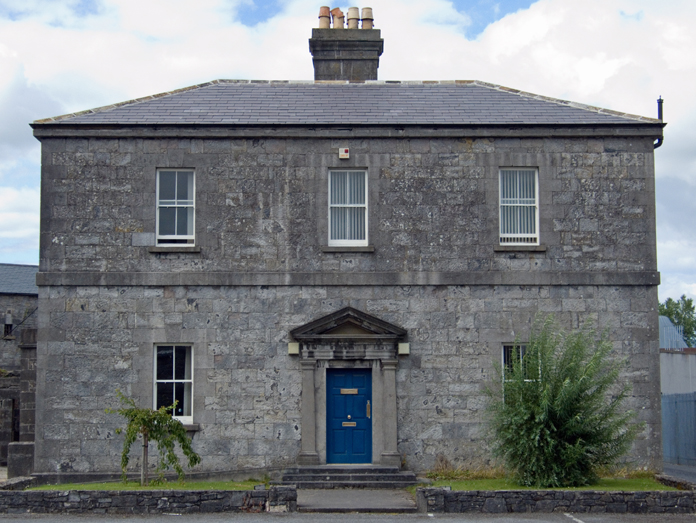
Figure 3: The governor’s house which formed the nucleus of the Panopticon and which was originally rivalled only by the guard house, an austerely-detailed pedimented pavilion of sheer Ballysadare limestone construction, for architectural effect. A polygonal return housed a chapel and church accessed via long axial corridors opening off the cell blocks: an impenetrable strong wall ensured that no prisoner could gain entry into the governor’s house
The governor had a surprisingly small workforce under his charge. The Fourth Report of the Inspectors General on the General State of the Prisons of Ireland (1826) lists the individual members of staff, and the salaries paid, including the governor (£250), assistant governor (£55) and turnkeys (£50 and £20). A medical officer or physician (£70) and matron (£10) cared for the infirm while two chaplains, one Church of Ireland and one Roman Catholic, were responsible for the spiritual welfare of the inmates and received no payment for their services. A clerk (£30) and schoolmaster (£15) were also on the payroll while, in time, a barber was taken on to curb the spread of lice. The Twenty-Seventh Report of the Inspectors-General on the General State of the Prisons of Ireland (1849), detailing an inspection carried out on the 9th September 1848 when the prison population had swelled to 264, saw twenty-two staff on the books including a management team of governor, deputy governor and local inspector; a core staff of ten turnkeys with one, William McDonogh, doubling as the schoolmaster; a clerk; a medical team of physician, apothecary, matron, assistant matron and nurse; and three chaplains serving Church of Ireland, Roman Catholic and Presbyterian inmates. The total salaries amounted to £807 2s. 2d..
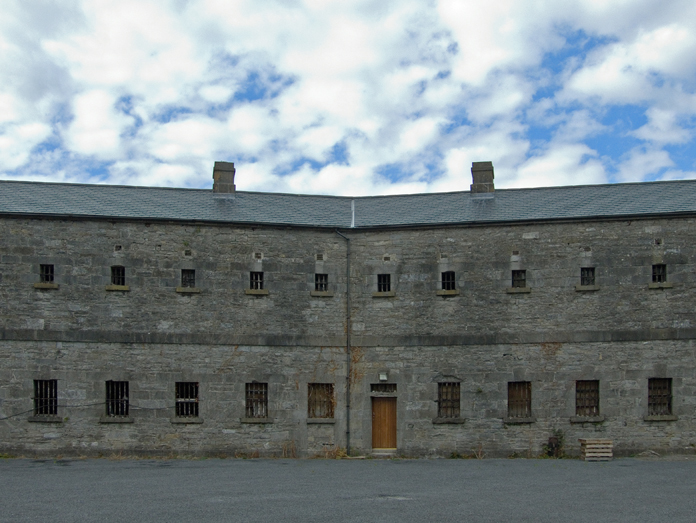
Figure 4: Although much of Sligo Gaol was demolished in the period between 1974 and 1981, including the hospital and female prison, what survives is regarded as the most complete example of the Panopticon or polygonal plan in Ireland: contemporary county gaols in Galway (1808-9), Carrick-on-Shannon (1813), Roscommon (1814-7), Ennis (1820), Lifford (1821-5), Mullingar (1823), Longford (1825), Naas (1825-33), Tullamore (1826) and Trim (1827) survive to a lesser degree or have been lost entirely. Five of the eight faceted cell blocks survive with the ground floors lit by conventional sash windows and the first floor cells showing characteristic iron bars
An examination of contemporary gaols operating across Ireland provides an insight into the regimented daily life of the prisoner in the early nineteenth century. Inmates were woken each morning at half past six but were allowed to sleep until shortly after seven on Sundays. A period of exercise and labour was followed by breakfast at 8 o’clock. Hard labour took up the remainder of the day with each shift averaging between twelve and fourteen hours interspersed with short breaks for exercise, food, instruction and prayer.
A treadmill was installed in Sligo Gaol in 1823 at a cost of £3,300. The treadmill provided a dual purpose in that it supplied enforced exercise to the prisoners while raising water from the Garvogue River to fill the tanks for flushing drains and sewers. Other hard labour included, in the case of male prisoners, oakum picking, stone breaking and wood chopping. Lighter duties included carpentry, gardening, painting, shoemaking, tailoring and tinsmith work. Female prisoners were occupied knitting, sewing and washing. All articles manufactured by the prisoners, with the exception of firewood, oakum and stones, were sold to the general public with the profits going towards the upkeep of the prison.
After a number of years of teething problems, documented in detail by an increasingly despairing inspector general, Sligo Gaol eventually settled into a quiet routine of discipline and order. In the Ninth Report of the Inspectors General on the General State of the Prisons of Ireland (1831) Major Palmer noted that ‘it is gratifying…to be able to report this prison greatly improved in every respect. The want of constant employment hitherto prevented Sligo gaol from keeping pace with others in discipline and good order. I found every prisoner at work, a good tread-mill established, and each criminal had a sleeping cell; these circumstances alone are calculated to make confinement a punishment, as the law purposes, and give some hope of working reformation in characters not altogether depraved… I found the prison remarkably clean, the officers zealous and attentive to their duty, and the additional buildings erected by the liberality of the grand jury has provided such accommodation and classification as to enable the local inspector and governor to establish a system and discipline creditable to the county’.
The rewards for long days of labour were meagre and the Sixth Annual Report of the Poor Law Commissioners published in 1840 reveals that the inmates of Galway, Longford, Maryborough [Portlaoise], Mayo, Roscommon and Sligo gaols shared the same daily diet with a breakfast of 8oz. oatmeal and 1 pint of milk, a dinner of 4lbs. potatoes and 1 pint of sour milk, and no supper.
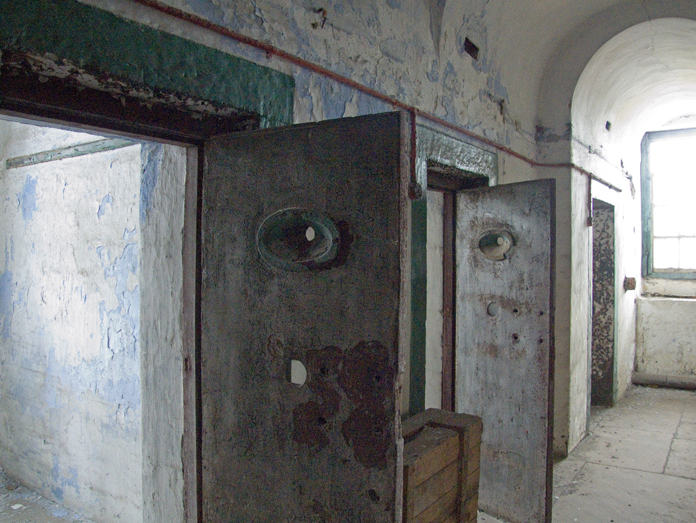
Figure 5: The cell blocks, long empty, still give an insight into the living conditions of the prisoners with long stone flagged corridors, limewashed to prevent the spread of cholera and typhus fever, flanked by rows of heavy cast-iron doors. A lamp held aloft to the small aperture overhead cast a beam of light into the cell and allowed the prisoner to be observed by the warder or turnkey through the spy hole in the door. A similar system was adopted in early cellular asylums, including the Central Mental Hospital in Dublin, in the period before the so-called Nightingale ward system
Sligo Gaol was used to detain a number of notable inmates over the course of its history including Michael Davitt (1846-1906) who was briefly imprisoned in 1879 following his speech to the first meeting of the Land League held at Gurteen. The news of his detention gripped the nation and was even reported in The New York Times.
In April 1918 Michael Collins (1890-1922) was sentenced to three weeks solitary confinement in Sligo Gaol following his arrest and trial for making a seditious speech calculated to cause disaffection in County Longford. A recurring theme of his “prison diary” (2nd-21st April) are his sleepless nights which he blames on a mattress described as ‘an awful thing. Reminds me of a sack half filled with sods of turf, except that the lumps of fibre didn’t seem to be as pliable as the sods of turf’ and which he later blames for ‘still another sleepless night. Must try to get this wretched mattress changed’.
On the 26th June 1920, at the height of the War of Independence (1919-20), a daring raid helped Francis Joseph “Frank” Carty (1897-1942), Officer Commanding (OC) of the South Sligo Brigade of the IRA, to escape the confines of the prison walls. Carty subsequently escaped from Derry Gaol in early 1921 but an attempt to flee justice in Glasgow ended in failure.
The last public hanging in Sligo took place on the 19th August 1861 when Matthew Phibbs, the so-called “Ballymote Slasher”, was executed for the murder of William and Fanny Callaghan and a servant girl named Anne Mooney. The last person to be hanged within the walls of Sligo Gaol was a Mr. Doherty of Carrick-on-Shannon who was executed in 1903 for the murder of his son.
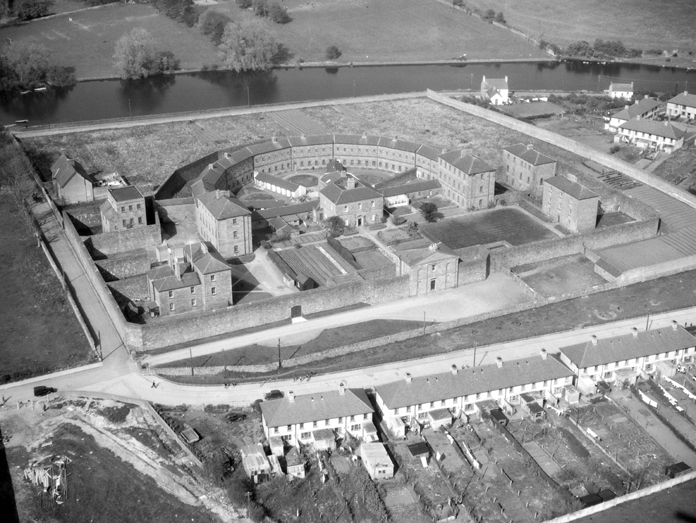
Figure 6: An aerial photograph from the 1950s showing the Sligo Gaol complex when it was still entirely intact with the cell blocks forming a polygonal arc around the central governor’s house. The marshalsea and flat-roofed treadmill are visible on the left of the photograph and are mirrored on the right of the photograph by the hospital and female prison respectively
The 1901 Census Prison, Bridewell, and Police Station Return Form lists twenty-four male prisoners by their initials and their crimes while the 1911 Census Prison, Bridewell, and Police Station Return Form lists forty-one male prisoners and five female prisoners. In 1956 the Minister for Justice, James Everett T.D. (1894-1967), proposed the closure of ‘the prisons at Cork and Sligo in which the daily average number of prisoners in custody last year was no more than fifteen and eight respectively. Nor was this a freak year, as the daily averages have been low in these two prisons for several years’. Sligo Gaol closed on the 25th April 1956 when the last governor, John Francis Moody (1898-1958), supervised the transfer of the remaining prisoners to Mountjoy Gaol in Dublin. Ownership passed to Sligo County Council in 1957 and it was the intervention by a concerned council employee that prevented the total demolition of the complex in 1963. Nevertheless, over time some key buildings were lost including the easternmost cell blocks, the hospital and female prison, the treadmill and a section of the boundary wall including the guard house.
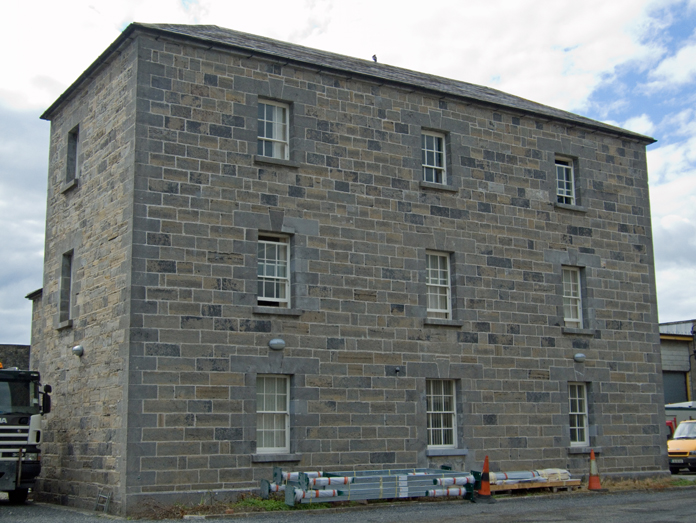
Figure 7: The marshalsea, used to detain male debtors, was originally mirrored on the opposite side of the forecourt by a hospital demolished in 1981. The marshalsea and nearby governor’s house have been successfully repurposed as offices while ongoing conservation work has attempted to halt the deterioration of the cell blocks and preserve their atmospheric interiors
The governor’s house and marshalsea have since been successfully repurposed as offices although the surviving cell blocks stand largely empty. In 2010 Sligo County Council, with the support of The Heritage Council, commissioned a conservation plan for Sligo Gaol. The priority of the conservation plan is to ensure that the buildings are weather tight and their atmospheric interiors are preserved. Conservation work on the cell block windows, supported by The Friends of Sligo Gaol and The Heritage Council, is ongoing. The establishment of the Friends of Sligo Gaol has provided a platform for wider community engagement with the architectural heritage of Sligo Gaol. In 2018, to mark two anniversaries, the bicentenary of the gaol and the centenary of the detention of Michael Collins, the Friends of Sligo Gaol organised a conference and the publication of My Tale Untold which, inspired by real characters and events, tells the story of a young girl in the 1800s who finds herself imprisoned in Sligo.
Sligo County Council, in partnership with the Friends of Sligo Gaol, are currently working towards securing funding to carry out a feasibility study to explore future sustainable uses for the complex and to chart a new chapter in the long history of Sligo Gaol. For more information visit www.sligogaol.ie
Siobhán Ryan, Heritage Officer, Sligo County Council
Back to Building of the Month Archive